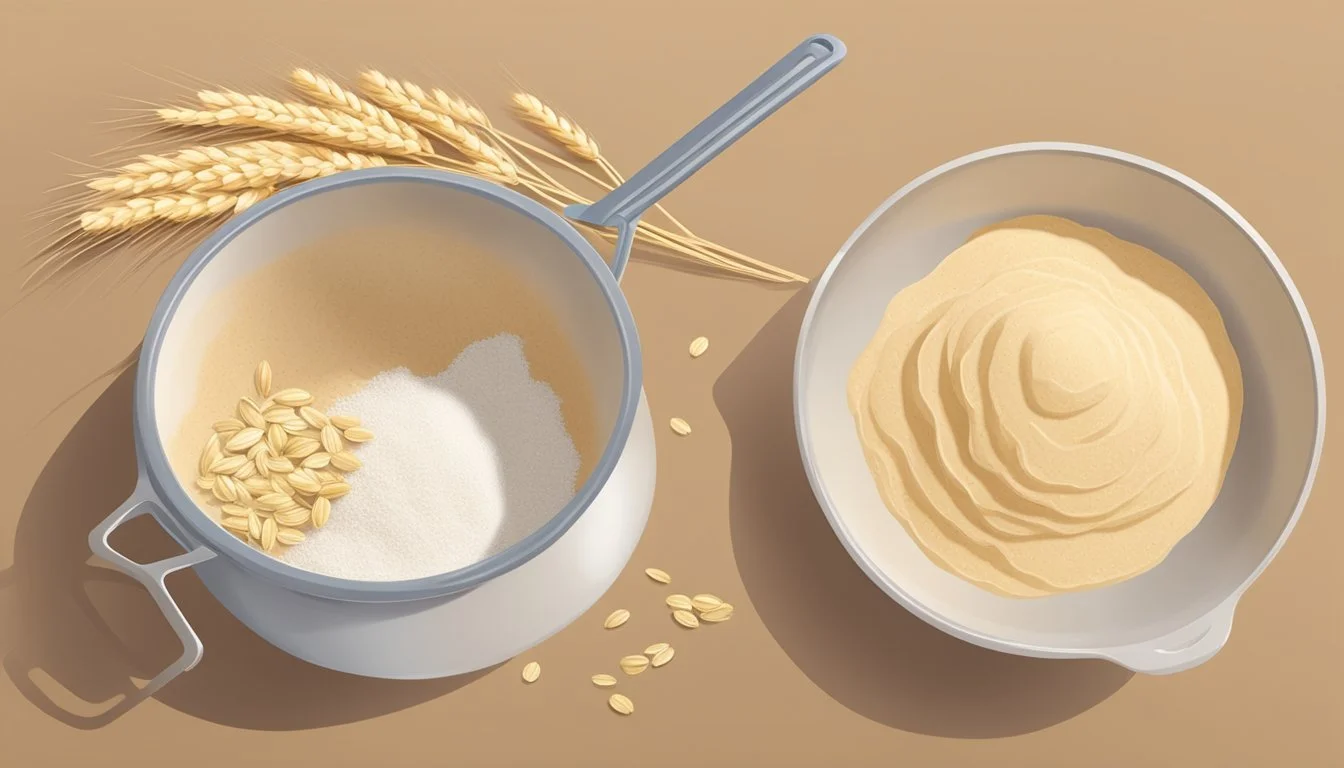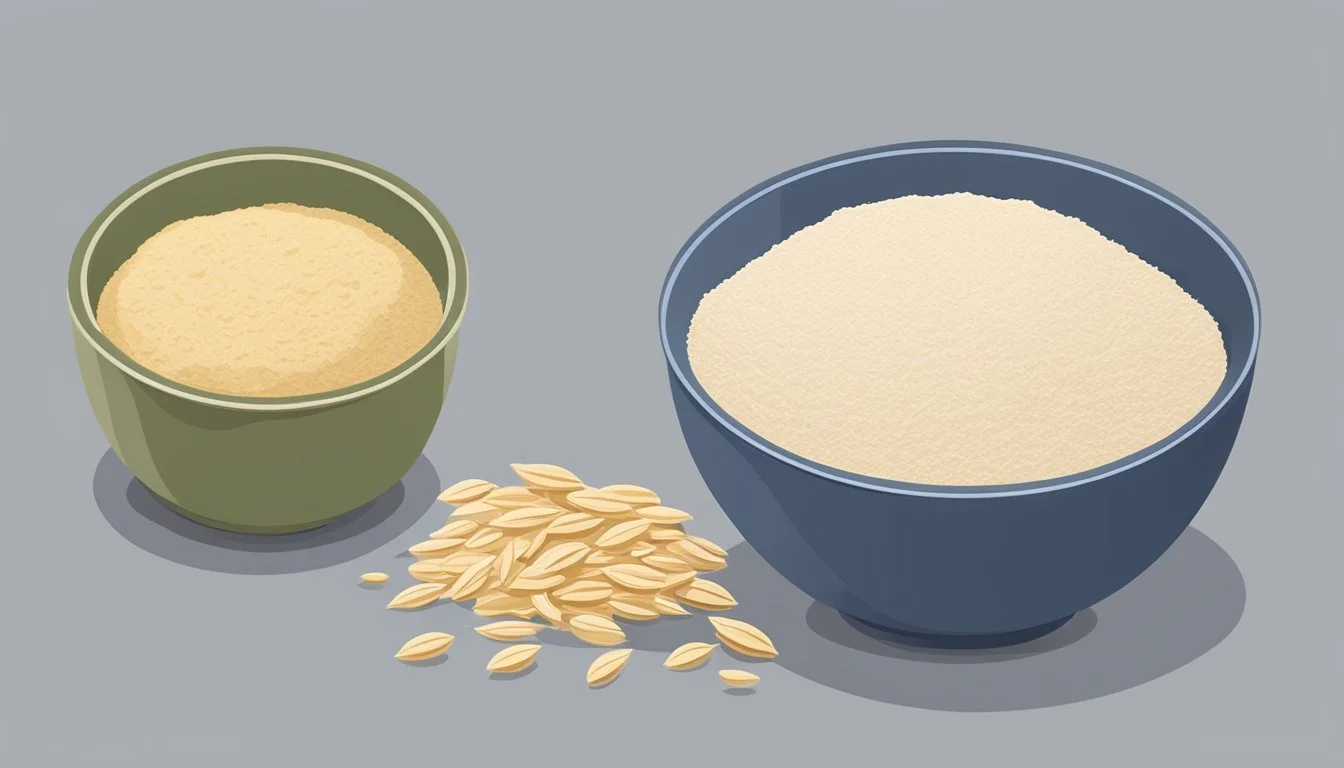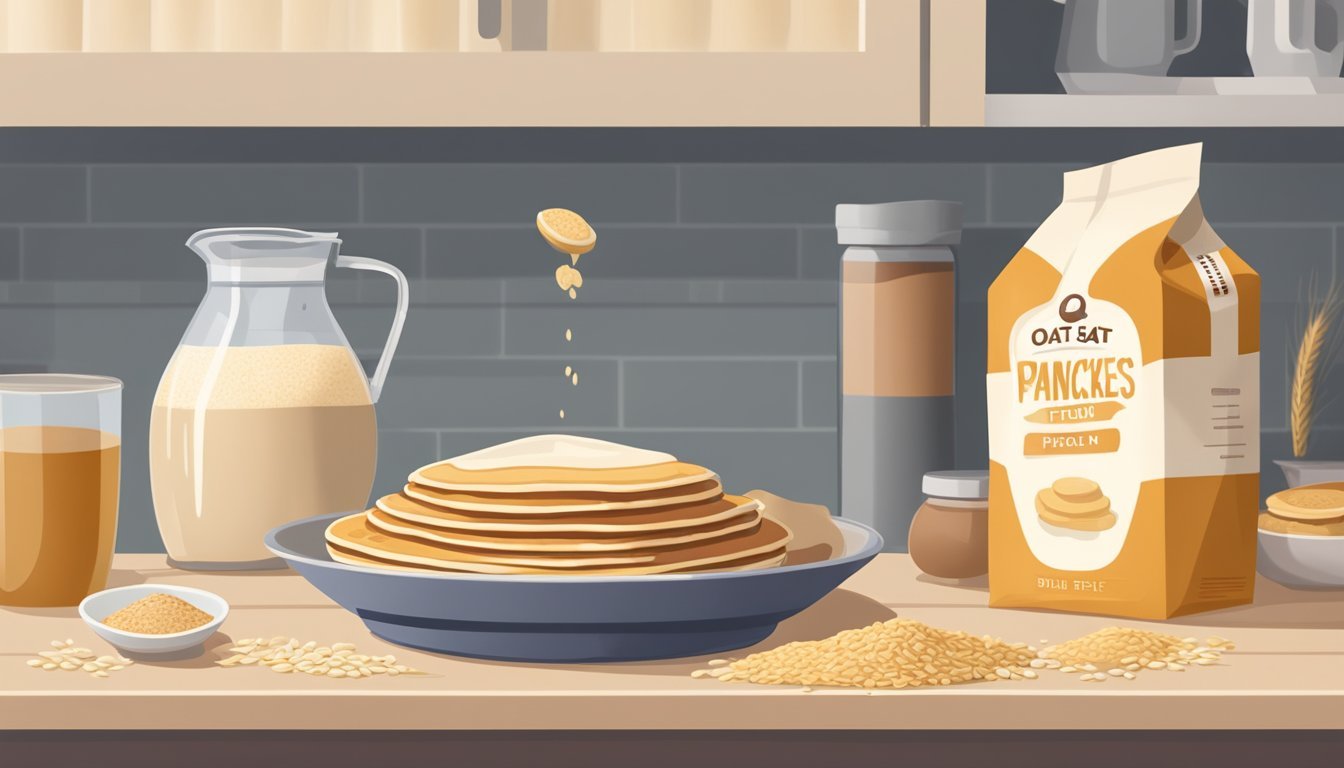How to Substitute Oat Flour for Wheat Flour in Pancakes
A Simple Guide
Substituting oat flour for wheat flour in pancakes offers a nutritious alternative that accommodates dietary restrictions and adds a new dimension to a beloved breakfast staple. Oat flour, derived from ground oats, is naturally gluten-free and contains a higher fiber content compared to traditional wheat flour, making it a healthier alternative for those looking to incorporate more whole grains into their diet. When making pancakes, utilizing oat flour not only caters to those with gluten sensitivities but also enhances the nutritional profile of the dish with its beneficial fats and proteins.
While oat flour can replace wheat flour in pancake recipes, the swap isn't a straightforward one-to-one ratio due to differences in absorption and consistency. The unique properties of oat flour mean adjustments are often necessary to retain the desirable texture and fluffiness associated with classic pancakes. Typically, more oat flour is required to match the volume of wheat flour originally called for in the recipe; a common guideline is to use a 1.42 times the amount of oat flour. Additionally, the batter may require more liquid to achieve the correct consistency, ensuring that the pancakes remain tender and easy to cook.
Navigating the substitution of oat flour in place of wheat flour aligns with a growing interest in exploring alternative ingredients in baking. This shift not only broadens the culinary experience but also provides a means for those with specific nutritional goals or dietary needs to enjoy pancakes. The focus remains on producing a satisfying and tasty result while optimizing health benefits and accommodating individual dietary preferences.
Understanding Flour Basics
When substituting flours in baking, it is crucial to understand their composition and how they behave differently during the cooking process. This knowledge ensures successful modification of recipes, such as using oat flour instead of wheat flour for pancakes.
Composition and Role of Flour in Baking
Flour functions as the foundational structure in most baked goods. It is primarily composed of starch and protein, of which gluten is a key form in wheat flour. Gluten gives elasticity and strength to dough, allowing it to trap gases produced by leavening agents, which causes the rise in baked products.
Key components of flour include:
Starch: A carbohydrate providing structure and tenderness.
Protein: Including gluten, it contributes to dough elasticity and firmness.
Fiber: Present in whole-grain flours, adding nutritional value and affecting moisture content.
Differences Between Wheat Flour and Oat Flour
Wheat flour is often categorized into all-purpose, bread, and whole wheat, with varying protein contents that make them ideal for different baking purposes. All-purpose flour is versatile, with a moderate protein level suited for pancakes, cakes, and bread.
Oat flour, on the other hand, is made from ground oats and is inherently gluten-free. It provides a denser texture and a slightly sweet, nutty flavor. Compared to wheat, it has higher fiber content, beneficial for health but can affect the moisture and texture of the final baked product.
Aspect Wheat Flour Oat Flour Gluten Content High (except gluten-free varieties) Gluten-free Protein Higher in bread flours, moderate in all-purpose Typically lower than wheat Fiber Often lower, higher in whole wheat varieties Generally higher, as oats are a whole-grain food Baking Characteristics Elastic and strong, traps gases well Denser, may require additional liquid Flavor Profile Neutral, varies by type Nutty, sweet
When substituting oat flour in recipes calling for wheat flour, adjustments to liquid and leavening may be needed due to these differences.
Adjusting Pancake Recipes
When substituting oat flour for wheat flour in pancake recipes, one must consider the different properties of oat flour such as its gluten content and absorbency. These factors affect the texture and binding of the pancakes.
Substitution Ratios for Oat Flour
For every cup of wheat flour in a recipe, substitute with approximately 1.4 cups of oat flour to achieve a similar consistency. This compensates for oat flour's denser nature.
Wheat Flour: 1 cup
Oat Flour: 1.4 cups
On average, a recipe calling for 1.75 cups of wheat flour will require about 2.5 cups of oat flour.
Modifying Wet Ingredients
Oat flour has a different absorbency rate compared to wheat flour; it requires more liquid to hydrate properly. If the pancake recipe calls for 1 cup of milk when using wheat flour, consider adding an extra 1/4 cup of liquid (such as milk, oat milk, or almond milk) for oat flour.
Original Milk Requirement: 1 cup
Adjusted Milk Requirement: 1.25 cups
Furthermore, when using oat flour, it might be beneficial to let the batter sit for a few minutes to properly hydrate before cooking.
Considering Protein Content and Gluten Formation
Since oat flour lacks gluten compared to wheat flour, pancakes made with oat flour will not have the same elasticity. Gluten provides structure, so for binding purposes, an additional egg or an egg substitute can be used to add protein and help bind the ingredients together.
Eggs in Wheat Flour Recipe: 1
Eggs in Oat Flour Recipe: 1-2 (depending on size and desired texture)
Mixing and Cooking Techniques
When substituting oat flour for wheat flour in pancakes, one must pay close attention to the consistency of the batter and the cooking process to ensure the pancakes are light and fluffy.
Achieving Desired Consistency
For oat flour pancakes, the batter should be thick but pourable to create a light structure. Since oat flour absorbs more liquid, additional liquid may be required. A general ratio to start with is adding an extra 1/4 cup of liquid for every 1 cup of oat flour used. The proper incorporation of leavening agents, such as baking powder, is crucial for that airy lift. One might consider increasing baking powder slightly, as oat flour is denser than wheat.
Avoiding Overmixing
To keep pancakes fluffy, it’s important to mix the batter until just combined; overmixing can lead to dense, chewy pancakes. Small lumps in the batter are acceptable—they indicate that air is trapped inside, which will expand upon cooking. Overmixing can also burst these air pockets, reducing fluffiness.
Cooking Pancakes to Perfection
Cooking pancakes requires a preheated skillet or griddle. For best results, heat should be medium to medium-high to cook through without burning. Pancakes are ready to flip when bubbles form on the surface and the edges look set. Flipping should be gentle to maintain airiness. Oat flour pancakes may require a slightly lower temperature and a longer cook time than wheat flour pancakes to achieve a golden brown exterior and fully cooked interior without burning.
Flavor and Nutrition Enhancements
Substituting oat flour for wheat flour in pancakes not only brings a distinct taste but also enhances the nutritional content significantly. Oat flour adds a mild, nutty flavor and increases the dietary fiber and protein in the pancakes.
Adding Flavorful Ingredients
To amplify the natural taste of oat flour pancakes, one can include a variety of flavorful ingredients.
Maple Syrup: A dash of maple syrup can be mixed into the batter for a subtle sweetness with a rich, caramel-like undercurrent.
Cinnamon: A sprinkle of cinnamon in the batter will infuse the pancakes with a warm, spicy note.
Other additions can comprise:
Fruit: Fresh or dried fruits such as blueberries, bananas (how long do bananas last?), or apples.
Toppings: Greek yogurt or a drizzle of honey for extra sweetness.
Boosting Nutritional Value
Oat flour inherently enhances the nutritional value of pancakes by supplying more fiber and potentially a lower glycemic index compared to traditional wheat flour. Here are specific ways to enrich the nutritious content:
Increase Fiber: One cup of oat flour can contain approximately 12 grams of fiber, beneficial for digestive health.
Potassium: Adding a banana not only has flavor benefits but also boosts the potassium content, aiding in muscle function and heart health.
Nutritional additives may include:
Chia or flax seeds for omega-3 fatty acids and additional fiber.
Nuts for protein and healthy fats.
Special Considerations for Dietary Needs
When substituting oat flour for wheat flour in pancakes, it's crucial to account for specific dietary needs. Oat flour naturally caters to gluten-free diets, but incorporating it effectively requires attention to detail, especially when addressing vegan requirements and allergen concerns.
Vegan and Gluten-Free Alternatives
For individuals seeking vegan and gluten-free pancakes, oat flour serves as an excellent base; however, they must ensure that the oats are certified gluten-free to avoid cross-contamination with wheat. To replace eggs typically used in pancake recipes, one can opt for one of the following vegan binders:
1 tablespoon of flaxseed meal mixed with 2.5 tablespoons of water (let sit until it thickens)
1/4 cup of unsweetened applesauce
1 mashed banana
Dairy can be substituted with plant-based milks such as almond milk or coconut milk. These alternatives not only maintain the pancake structure but also impart unique flavors and nutritional profiles.
Managing Allergies and Intolerances
When addressing nut allergies, one should avoid almond flour and instead consider other gluten-free flours like rice flour or chickpea flour as a partial mix with oat flour to improve texture and taste. This table outlines suitable replacements:
Allergen Replacement Options Nuts Coconut flour, rice flour Dairy Soy milk, oat milk Eggs Chia seeds, aquafaba
The addition of coconut flour may result in thicker batter, thus extra liquid might be necessary. Corn flour can also be a substitute, albeit with a distinctive flavor and heavier consistency. For each allergen sensitive ingredient, careful selection of substitutions assures that the dietary restrictions are adhered to without sacrificing the quality of the pancakes.
Storing and Preserving Pancakes
When it comes to preserving oat flour pancakes, the key to maintaining their freshness and flavor lies in proper storage and reheating techniques. Here are structured methods to ensure this.
Freezing and Reheating Methods
Pancakes freeze exceptionally well, making them a convenient make-ahead meal. To freeze oat flour pancakes:
Cool Completely: Ensure pancakes are at room temperature to avoid condensation and freezer burn.
Layer Separately: Place a sheet of parchment paper between each pancake to prevent sticking.
Airtight Containers: Store them in an airtight container or resealable freezer bags to prevent air from drying them out.
For reheating:
Toaster: Quick and convenient, toasting frozen pancakes can give them a crisp edge.
Oven: Reheat in a preheated oven (350°F) for about 10 minutes, wrapped in foil to retain moisture.
Microwave: For a softer texture, microwave on high for 30-60 seconds, but be cautious of overdoing it as they can become rubbery.
Long-Term Storage Tips
For long-term storage, oat flour pancakes can last in the freezer for up to two months. To maintain quality:
Use Freezer-Safe Containers: Make sure all containers are freezer-proof to protect the pancakes against freezer burn.
Label and Date: Label each container with the current date for proper rotation and usage before the two-month mark.
In the refrigerator, pancakes can be kept in an airtight container for a few days, but they are best enjoyed when fresh.
Remember, the texture and taste might slightly change after freezing, but properly stored oat flour pancakes should still provide a satisfying meal upon reheating.







